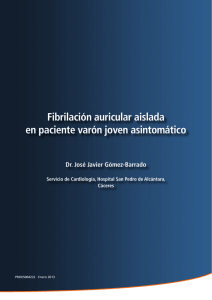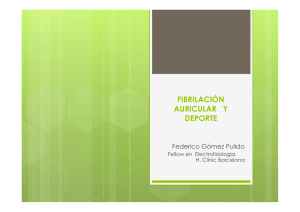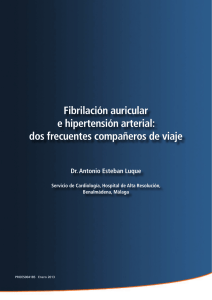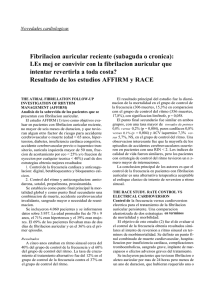Control de ritmo vs control de frecuencia
Anuncio
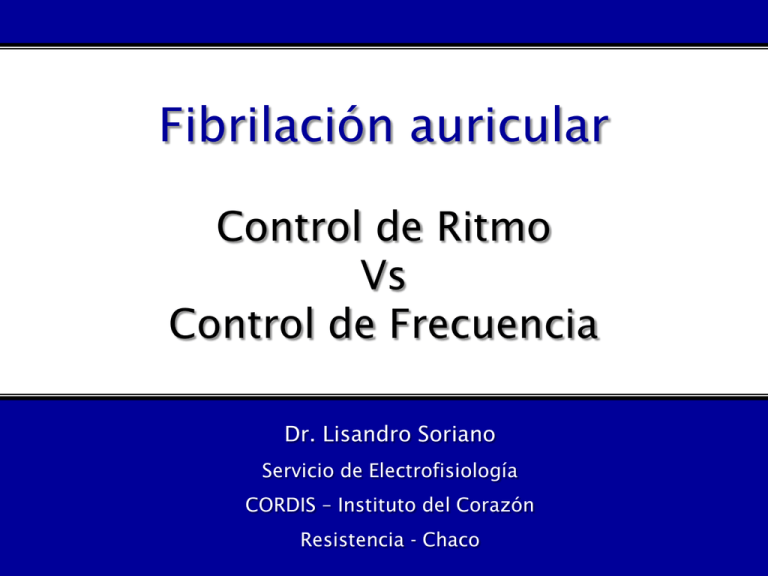
Fibrilación auricular Control de Ritmo Vs Control de Frecuencia Dr. Lisandro Soriano Servicio de Electrofisiología CORDIS – Instituto del Corazón Resistencia - Chaco FIBRILACION AURICULAR Es la arritmia sostenida sintomática mas frecuente Su incidencia aumenta con la edad y con la presencia de enfermedad cardiaca estructural. Es la mayor causa de Stroke en la vejez. Es una importante causa de hospitalización. Fibrilación Auricular: Incidencia por Edad Población x 1000 Población con FA x 1000 Población con FA 30,000 500 400 Población Total 20,000 300 200 10,000 100 0 0 <5 5- 10- 15- 20- 25- 30- 35- 40- 45- 50- 55- 60- 65- 70- 75- 80- 85- 90- >95 9 14 19 24 29 34 39 44 49 54 59 64 69 74 79 84 89 94 Edad. años Adapted from Feinberg WM. Arch Intern Med. 1995;155:469-473. FIBRILACION AURICULAR CLASIFICACION FA Primer Episodio PAROXISTICA PERSISTENTE Autolimitada dentro de 7 días No Autolimitada LONG STANDING PERSISTENT AF Mas de un año de duración PERMANENTE Consecuencias de la Fibrilación auricular Hemodinámicas • Pérdida de la sincronía AV („atrial kick‟) • Despolarización ventricular irregular • Inapropiado incremento de la frecuencia con el ejercicio • Cardiomiopatía relacionada con respuesta ventricular rápida (Taquicardiomiopatía) Hemorreológicas • Activación del sistema plaquetario y de la coagulación • Complicaciones Tromboembólicas PROBLEMAS COMUNES Tromboembolia (secundaria a trombos en AI) Hospitalización en ptes con FA AGUDA o FAARV. Anticoagulación, especialmente en ptes > 75 años Insuficiencia Cardíaca congestiva . Pérdida sincronía AV . Pérdida contracción auricular ( atrial “kick” ) . Taquicardiomiopatía debido a respuesta ventricular rápida Miopatía auricular y dilatación (Remodeling) Síntomas crónicos y alteración calidad de vida TRATAMIENTO PREVENCIÓN EVENTOS EMBÓLICOS CONTROL DE FRECUENCIA CONTROL DEL RITMO RIESGO DE EMBOLIA DE LOS DIFERENTES FACTORES DE RIESGO EN FIBRILACION AURICULAR Gage, et al. National Registry of Atrial Fibrillation. JAMA 2001;285:2864– 70. CHADS 2 ESTRATIFICACION DE RIEGO SCORE ACV Previo/AIT 2 Edad > 75 años 1 Hipertensión 1 Diabetes Mellitus 1 Insuficiencia Cardíaca 1 CHADS ≥ 2 debería recibir ACO La adición de Clopidogrel a AAS para reducir el riesgo de eventos vasculares mayores (stroke), debe ser considerado en pacientes con FA, en quienes la anticoagulacion oral con warfarina es considerada no recomendable debido a la preferencia del paciente, medico o la inseguridad del tratamiento. (Nivel de evidencia: B) DABIGATRAN (RELY): En dosis de 150 mg dos veces por día, demostró la no inferioridad respecto a Warfarina (reducción de Stroke) Circulation. 2011;123:104-123 CONTROL DE FRECUENCIA Control estricto de la FC: 80 lpm en reposo y hasta 115 lpm en la caminata de 6 minutos. Control no estricto de la FC: menos de 110 lpm en reposo. Fármacos utilizados para control de frecuencia cardíaca Droga Control del episodio Digoxina 0,25mg c/4-12 hs hasta 1 mg. Diltiazem 0,25 mg/Kg. bolo. 180 - 360 mg./día. Verapamilo 5-10 mg en 2 min. 120 - 360 mg./día. Atenolol 5 mg. Repetir según tolerancia Amiodarona !! 5 mg/Kg e.v Control FA persistente 0,125 - 0,5 mg/día. 25 - 200 mg/día. 200 -400 mg./día. • Estudio randomizado a dos ramas (pctes con FA permanente de mas de 12 meses) 1) Control estricto de la FC: menos de 80 lpm y menos de 110 lpm en la 6MWT 2) Control no estricto de la FC: menos de 110 lpm • End Point compuesto: mortalidad, insuficiencia cardiaca, reacciones adversas de las drogas, paro cardiaco, necesidad de implante de MCP. Mayor N de drogas en control estricto (P<0.001) No inferioridad N Engl J Med 2010;362:1363-73. Control de la frecuencia Ventajas: • Bajo riesgo de proarritmias. • Buena tolerancia. Desventajas: • Pérdida de adaptación a la actividad. • Presencia de síntomas más frecuente. • Anticoagulación prolongada . COMO DEBE SER EL CONTROL DE LA FC DURANTE LA FIBRILACION AURICULAR El tratamiento para el control estricto de la frecuencia cardiaca (80 lpm en reposo y 110 lpm en 6 MWT) no tiene beneficio comparado con el control (no estricto) a menos de 110 lpm en reposo en pacientes con FA persistente que tienen una función ventricular estable (FEVI ≥40%) y no tienen síntomas relacionados a la arritmia. Estos pacientes deben controlarse ya que la taquicardia a través del tiempo puede producir un deterioro reversible de la FSVI. (Nivel de evidencia B) Circulation 2011;123;104-123 Control de Frecuencia PACIENTES AÑOSOS SEDENTARIOS BAJA FE-ICC DIGOXINA BETA BLOQUEANTES PACIENTES ACTIVOS BUENA FUNCIÓN BETA BLOQUEANTES ANT. CÁLCICOS CONTROL DE RITMO FIBRILACION AURICULAR AGUDA (˂ 48 hs de evolución) METODO Cardioversión eléctrica: EFECTIVIDAD 90% POSIBLES R.A. Anestesia, dolor, irritación paro sinusal, disfuncion de MCP, FV. Quinidina: 24 – 88% Flecainida: 90% Prolongacion de la despolarizacion. Propafenona: >83% Prolongacion de la despolarizacion Sotalol: ˂ 50% Amiodarona: 55 - 95% Ibutilide y dofetilide: 60% Intolerancia GI, QT largo Prolongacion del QT, bradicardia Prolongacion del QT FA menor a 48 horas Inestabilidad hemodinámica CVE Hemodinámicamente estable Sin cardiopatía Con cardiopatía Propafenona Flecainida Amiodarona Amiodarona CONTROL DE RITMO FIBRILACION AURICULAR PAROXISTICA (mantenimiento del ritmo sinusal) Flecainida: 100 – 300 mg/dia Propafenona: 300 – 900 mg/dia Sotalol: 160 – 320 mg/dia Amiodarona: 200-600 mg Dronedarone 400 – 800 mg/dia CVE en FA persistente (ETE previo o ACO en rango por 3 semanas) No olvidarse del tratamiento facilitado con antiarritmicos. AFFIRM: Mantenimiento del RS AFFIRM SUBSTUDY INVESTIGATOR. JACC 2003 Uso de DA para mantenimiento de RS luego de cardioversión 100 % Event-free patients 80 Stage I Flecainida Stage II Sotalol Stage III Amiodarona 60 40 20 Stage I Stage II Stage III 127 53 34 56 29 20 47 23 12 43 16 11 43 13 6 43 13 3 43 10 3 40 6 1 40 6 1 0 0 5 10 15 20 25 Months follow-up Crijns HJ. Am J Cardiol. 1991;68:335-341. • Estudio multicéntrico que probo DRONEDARONA vs Placebo en pacientes con FA paroxística o persistente mas algún factor de riesgo cardiovascular. • End Point combinado: internación por ICC y mortalidad N Engl J Med 2009;360:668-78 N Engl J Med 2009;360:668-78 N Engl J Med 2009;360:668-78 CLASE II A El uso de Dronedarone es razonable para disminuir la necesidad de hospitalización por eventos cardiovasculares en pacientes con FA paroxística o Persistente con cardioversión a RS. (Evidencia: B) CLASE III Dronedarone no debe ser administrado a pacientes con insuficiencia cardiaca en CF IV o pacientes con IC descompensada en las 4 semanas previas especialmente si presentan una FEVI < 35%. (Evidencia B) Control del Ritmo vs. Control de la Frecuencia: Ensayos Clínicos Randomizados FU Punto final Control FC Control Ritmo Valor P 61 1 año Mejoría sintomatica 60.8% 55.1% .317 200 66 19.6 m. Combinado * 9% 10% NS RACE 522 68 2.3 años Combinado ** 17.2% 22.6% .11 AFFIRM 4060 69.7 3.6-6 años Mortalidad Total 25.9% 26.7% .08 Estudio N° Edad PIAF 252 STAF Fibrilación Auricular: Ensayos Clínicos Randomizados Grupo Control del Ritmo • PIAF: 56% en ritmo sinusal al año, mejor tolerancia al ejercicio, más hospitalizaciones (69% vs. 24% y mayores efectos adversos (64% vs. 47%). • STAF: 23% en ritmo sinusal a 3 años, más hospitalizaciones y días de estadía. • RACE: 39% en ritmo sinusal a 2.3 años, mayores efectos adversos (4.5% vs 0.8%) • AFFIRM: 62.6% en ritmo sinusal a los 5 años. Mayor n° de hospitalizaciones (80.1% vs. 73.0 %) RACE • incluyo pacientes con FA y AA de menos de un año de duración. Se excluyeron los pctes que tomaban amiodarona. N: 522 •Control de FC: Se utilizaron digitalizos, BB y antag calcicos. El objetivo era una FC menor a 100 lpm en ECG de reposo. Si la FC no se controlaba o el paciente presentaba sintomas o deterioro de la FSVI se indicaba una CVE o una ablacion del NAV + MCP •Control de Ritmo: CVE + Primero se uso Sotalol (160-320mg), si habia recurrencia se cambio a Flecainida o Propafenona y con nueva recurrencia a Amiodarona. •Anticoagulacion: Control de Ritmo: se podia suspender la ACO 1 mes posterior a la CVE si el paciente estaba en ritmo sinusal. END POINT PRIMARIO (combinado): Muerte cardiovascular, IC, Tromboembolia, sangrado, necesidad de MCP, eventos adversos severos de las drogas antiarritmicas. RACE Conclusion: Control de la FC es una alternativa aceptable AFFIRM • Atrial Fibrillation Follow-up Investigation of Rhythm Management • Hipótesis: Efecto sobre la mortalidad de la terapia antiarrítmica para mantener ritmo sinusal vs. control de la frecuencia en presencia de anticoagulación. • Endpoint primario: Mortalidad Total • End point secundario: mortalidad total, stroke, encefalopatia anoxica, paro cardiaco, sangrado mayor N Engl J Med 2002;347:1825-33 N Engl J Med 2002;347:1825-33 AFFIRM P=0,08 Punto combinado: muerte, stroke, sangrado mayor, paro cardiaco fue similar en los dos grupos (P=0,33) N Engl J Med 2002;347:1825-33 N Engl J Med 2002;347:1825-33 N Engl J Med 2002;347:1825-33 N Engl J Med 2002;347:1825-33 AFFIRM Trial – Crossovers 594 pts pasaron de la estrategia Control de Ritmo a Control de Frecuencia debido a la imposibilidad de mantener RS o a intolerancia de las drogas. 248 pts pasaron de control de FC a Control de Ritmo, mayormente debido a sintomas o IC. AFFIRM, NEJM 2002; 347:1825 AFFIRM • No hubo diferencias en la mortalidad entre el grupo control de ritmo y control de frecuente. •Hubo mas hospitalizaciones y eventos adversos en el grupo control de ritmo. “Control de Frecuencia es una estrategia razonable para pacientes con FA” • 1376 pts. •FEVI < 35%, CF II-IV NYHA, Insuficiencia cardiaca con internación en los últimos 6 meses o FAVI <25%. •Exclusión: FA >12 meses, ICC descompensada •Control de ritmo: CVE y drogas (sotalol, amiodarona) •Control de FC: <80 reposo / <110 6MWT. BB +digoxina o ablacion del NAV + MCP. Fibrilación Auricular: Ensayos Clínicos Randomizados • Incluyeron un subgrupo de pacientes mayores y poco sintomáticos que no requieren ritmo sinusal. • No analizaron pacientes jóvenes, muy sintomáticos, con leve o sin enfermedad cardíaca estructural. • Sin poder estadístico en subgrupos con insuficiencia cardíaca (AF-CHF) o enfermedad cardíaca estructural (Ej:Miocardiopatías). • Dificil de aplicar los resultados a pacientes individuales • No evaluaron los beneficios de terapias no farmacológicas Relación entre ritmo sinusal, tratamiento y sobrevida en estudio AFFIRM Covariables asociadas significativamente con sobrevida Epstein et al. Circulation 2004 Mejoria en la capacidad de ejercicio y calidad de vida con el mantenimiento del ritmo sinusal. Mantenimiento del ritmo sinusal en pacientes bajo ABLACION DE FA con o sin drogas antiarrítmicas. Circ Arrhythmia Electrophysiol. 2009;2:349-361 Pcts con Fibrilacion auricular, insuficiencia cardiaca CF II-III, FEVI˂40% Randomizados a Ablacion de fibrilacion auricular vs Ablacion del nodo AV + Marcapasos biventricular. El end point primario combinado: Fraccion eyeccion VI, 6MWT, Calidad de vida. Seguimiento a los 6 meses. A los pts de la rama Ablacion del NAV se les implanto un MCP biventricular +CDI. Fueron randomizados 40 pts a cada rama de tratamiento. N Engl J Med 2008;359:1778-85 N Engl J Med 2008;359:1778-85 N Engl J Med 2008;359:1778-85 N Engl J Med 2008;359:1778-85 RECOMENDACIONES PARA MANTENER EL RITMO SINUSAL 2011 ACCF/AHA/HRS Focused Update on the Management of Patients With Atrial Fibrillation (Updating the 2006 Guideline) CLASE I La ablacion por catéter de fibrilación auricular en centros experimentados es util para mantener el RS en pacientes seleccionados sintomáticos, con FA paroxística, en quienes fallo el tratamiento antiarrítmico y tienen AI normal o levemente dilatada, FSVI normal o levemente reducida y sin evidencia de enfermedad pulmonar. (Evidencia: A) CLASE II La terapia farmacológica puede ser útil para mantener el ritmo sinusal y prevenir la taquicardiomiopatia (Evidencia: C) En paciente con FA sin cardiopatía estructural o enfermedad coronaria, el tto con Flecainida o propafenona puede tener beneficios en pacientes con FA paroxística, (Evidencia: B) La ablacion por catéter de fibrilación auricular es razonable para el tratamiento de la FA persistente sintomática. (Evidencia: A) Circulation. 2011;123:104-123 FIBRILACION AURICULAR - RECOMENDACIONES Individualizar la estrategia con cada paciente. Control de ritmo + anticoagulacion cuando hay sintomas o deterioro hemodinamico. Control de FC + ACO en estos pacientes es razonable. Control de ritmo en pacientes jovenes, sin cardiopatia. Evaluacion de las nuevas terapias antiarritmicas. Considerar la ablacion de fibrilacion auricular en pacientes seleccionados . GRACIAS POR SU ANTENCION Dr. Lisandro Soriano Servicio de Electrofisiología Cordis – Instituto del Corazón Resistencia - Chaco Ablación por Radiofrecuencia vs. Amiodarona después del primer episodio de AA sintomático (LADIP) Da Costa y col. Circulation 2006 Mantenimiento del ritmo sinusal Sin cardiopatía Flecainida Propafenona Sotalol -BB Con cardiopatía Enf. coronaria HTA ICC Sotalol-BB Amiodarona-BB Mayor a 1,4 cm Menor a 1,4 cm Flecainida-BB Propafenona Amiodarona en la Prevención de Fibrilación Auricular CTAF Study Roy y col. NEJM 2000 Fibrilación Auricular: Control de la Frecuencia vs. Control del Ritmo Qué pensábamos: Ventajas del Control de la FC - Bajo riesgo de eventos adversos - Menor mortalidad - Menor costo Ventajas del Control del RS - Mejoría sintomática - Mejor tolerancia al ejercicio - Bajo riesgo de stroke - Suspensión de anticoagulación - Reversión del remodelamiento El control del ritmo es mejor Fibrilación Auricular: Control de la Frecuencia vs. Control del Ritmo Qué pensábamos: Ventajas del Control de la FC - Bajo riesgo de eventos adversos? - Menor mortalidad? - Menor costo? Ventajas del Control del RS - Mejoría sintomática? - Mejor tolerancia al ejercicio? - Bajo riesgo de stroke? - Suspensión de anticoagulación? - Reversión del remodelamiento? El control del ritmo es mejor? Qué conocemos ahora: - Bajo riesgo de eventos adversos. - Tendencia a < mortalidad - Menos internaciones - Mejoría comparable - Mejor en pacientes jóvenes - Riesgo comparable - Debe ser continuada en pacientes seleccionados - No hay respuesta El control de la FC es una alternativa aceptable Estasis sanguíneo & FA Pérdida de la capacidad contráctil de la aurícula “humo” T Signos indirectos de flujo lento o éstasis sanguíneo en la aurícula Presencia de “humo” o contraste espontáneo (ETT / ETE) Análisis doppler de la orejuela “humo” T Our study tested a treatment strategy to maintain sinus rhythm. Use of a single drug could have yielded a different result (either better or worse), but the ability to use multiple drugs increased the chance that any individual patient would maintain sinus rhythm. Patients with frequent or severe symptoms might have been considered unsuitable for a rate-control strategy and therefore may not have been enrolled by some investigators. Moreover, the results probably cannot be generalized to younger patients without risk factors for stroke (i.e., patients with primary, or “lone,” atrial fibrillation), particularly those with paroxysmal atrial fibrillation. Nevertheless, our results apply to the majority of patients with atrial fibrillation. Finally, some of the patients in each of the two groups had paroxysmal atrial fibrillation, and thus, the prevalence of sinus rhythm at any time was high, even in the ratecontrol group. Patients with atrial fibrillation often need treatment for decades, not years. However, the survival curves appear to be diverging, not converging, later in followup. Furthermore, the adverse effects due to the most commonly used drug, amiodarone, might be reasonably expected to increase with longer use. None of the presumed benefits of rhythm control noted above were confirmed in this study. The implication is that rate control should be considered a primary approach to therapy and that rhythm control, if used, may be abandoned early if it is not fully satisfactory. Our data also suggest that continuous anticoagulation is warranted in all patients with atrial fibrillation and risk factors for stroke, even when sinus rhythm appears to be restored and maintained. BIBLIOGRAFIA PARA BUSCAR Corley SD, Epstein AE, DiMarco JP, Domanski MJ, Geller N, Greene HL, Josephson RA, Kellen JC, Klein RC, Krahn AD, et al. Relationships between sinus rhythm, treatment, and survival in the Atrial Fibrillation Follow-Up Investigation of Rhythm Management (AFFIRM) Study. Circulation 2004;109: 1509–1513. Pedersen OD, Bagger H, Keller N, Marchant B, Kober L, Torp-Pedersen C. Efficacy of dofetilide in the treatment of atrial fibrillation-flutter in patients with reduced left ventricular function: a Danish investigations of arrhythmia and mortality on dofetilide (DIAMOND) substudy. Circulation 2001;104:292–296 Pappone C, Rosanio S, Augello G, Gallus G, Vicedomini G, Mazzone P, Gulletta S, Gugliotta F, Pappone A, Santinelli V, et al. Mortality, morbidity, and quality of life after circumferential pulmonary vein ablation for atrial fibrillation: outcomes from a controlled nonrandomized long-term study. J Am Coll Cardiol 2003;42:185–197. Oral H, Chugh A, Ozaydin M, Good E, Fortino J, Sankaran S, Reich S, Igic P, Elmouchi D, Tschopp D, et al. Risk of thromboembolic events after percutaneous left atrial radiofrequency ablation of atrial fibrillation. Circulation 2006;114:759–765. Heart Rhythm, Vol 4, No 6, June 2007 Items a desarrollar: . Extremos en la desicion de controlar el ritmo o la frecuencia. (IC con AI muy grande, FA persistente de larga duracion, asintomaticos o corazones zanos con FA persistente sintomatica). . Anticoagulacion . Control de frecuencia cardiaca. Como la evaluamos. Cuando decimos que la FC esta controlada. Caminata 6 min. ECG. Holter. PEG. Funcion ventricular. Insuficiencia cardiaca. . Control de ritmo: como lo realizamos. Que droga utilizamos. . Ablacion de fibrilacion auricular. Una nueva perspectiva de tratamiento. Nos hace cambiar la estrategia. Biblio a buscar: 3. Waldo AL. Management of atrial fibrillation: the need for AFFIRMative action. Am J Cardiol 1999;84:698-700. 7. Benjamin EJ, Wolf PA, D’Agostino RB, Silbershatz H, Kannel WB, Levy D. Impact of atrial fibrillation on the risk of death: the Framingham Heart Study. Circulation 1998;98:946-52. Roy D, Talajic M, Nattel S, et al. Rhythm control versus rate control for atrial fibrillation and heart failure. N Engl J Med. 2008;358:2667–77. RACIONALIDAD PARA REALIZAR UNA ABLACION DE FA Several epidemiologic studies have shown strong associations between AF and increased risk of cerebral thromboembolism, development of heart failure, and increased mortality.55-57 It is well known that AF causes hemodynamic abnormalities including a decrease in stroke volume, increased LA pressure and volume, shortened diastolic ventricular filling period, AV valvular regurgitation, and an irregular and often rapid ventricular rate.58 Persistence of AF leads to anatomic and electrical remodeling of the LA that may facilitate persistence of AF. Most importantly, many patients, even those with good rate control, experience intolerable symptoms during AF. No se uso amiodarona Until these new trials are completed, it is important to tailor the treatment of AF to each individual patient. The young, healthy patient will likely benefit from a strategy to achieve and maintain sinus rhythm with a combination of cardioversion, antiarrhythmic drugs and possibly catheter ablation. On the other hand, it is not uncommon for older patients to have minimal to no symptoms with AF, particularly if they have some element of underlying conduction system disease and their ventricular rates in AF are moderate. In such cases, it is difficult to argue that restoration of sinus rhythm is necessary in these patients, given the clinical trial data we have to date. Thus, rate control and anticoagulation with warfarin would be a perfectly acceptable strategy. Patients with heart failure may be a particularly challenging group to manage. Options for rhythm control are somewhat limited, with amiodarone and dofetilide as the best options, and dronedarone reserved for selected patients who do not have a history of recently decompensated heart failure. Rate control may be difficult if patients do not tolerate adequate doses of bblockers or calcium channel blockers. Finally, ablation procedures are less successful in patients with persistent AF or enlarged left atria, which are more likely in patients with chronic systolic heart failur
